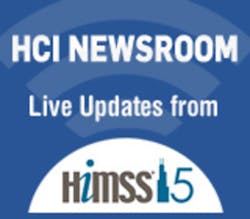Notes from Physicians’ IT Symposium: The Journey from Tech-Driven to Data-Driven Care
Bert Reese, senior vice president and chief information officer for 12-hospital Sentara Healthcare, says he used to think the hard part of working with an EHR was the selection and implementation. “I thought that after spending $300 million on an EHR I was done,” he told the Physicians IT Symposium at the HIMSS Pre-conference on April 12 in Chicago. “Later, I realized it wasn’t about the EHR but about the data it produced. We had to move from being a technology-driven to a data-driven company,” said Reese, who leads IT strategy for the Norfolk, Va.-based integrated health system with operations in southeastern Virginia and northeastern North Carolina.
Reese said Sentara has worked on improving the cycle time from “data to information to knowledge to action.” The organization that can do that fast will win regardless of which EHR they have, he added. By developing their organizational structures around data, healthcare organizations can position themselves for data opportunities coming down the road such as IBM’s Watson or translational genomics. Reese breaks down all data into three types: retrospective, dynamic and predictive, and he has structured Sentara’s data organization to match those three groups. He has created a federated model with a combination of enterprise responsibilities to decide on governance and tool sets, and self-service tools available for physicians and others to use.
Michael Zaroukian, M.D., Ph.D., vice president and chief medical information officer at Sparrow Health System in Lansing, Mich., gave a presentation on EHR usability efforts as well as how physicians might consider opportunities such as the new Clinical Informatics Board Certification. (He said in 10 to 15 years the board certification may be seen as a requirement to work in the field, just as board certification in emergency medicine is now to work in an emergency department.)
During the Q&A, physicians expressed concern about the rigidity and prescriptive nature they see continuing in Stage 3 of meaningful use. Zaroukian, who has served on ONC’s Meaningful Use Work Group, said he has seen an attempt to move away from rigid, prescribed work flows, but the “devil is in the details.” He recommended that everyone interested should make their feelings known to CMS because the numbers do matter in terms of how many objections CMS gets to proposals.
Echoing the concerns about meaningful use, during the closing keynote, Stanley Huff, M.D., Intermountain Healthcare CMIO, said, “Knowing what we know now, if not under threat of penalties, we probably would not have pursued the meaningful use incentives,” adding that if Intermountain hadn’t done meaningful use, its “patients would be receiving better care and our clinicians would be happier.”
Huff, who has served for many years on the Health IT Standards Committee, nevertheless was disappointed by the unintended consequences the program had on Intermountain’s operations. As an example he talked about immunization reporting. Although Intermountain already had a solution that shared immunization data with the state of Utah, it used an integrated database, not a messaging system. The certifying body told Intermountain that wouldn’t qualify because it didn’t use HL7 messages, even though it was actually a better architecture. “It cost us work to do it and it provides no value,” Huff said. Receiving millions in incentive payments wasn’t worth it, he noted. “There is no evidence it improved quality.”
Yet speaking more broadly about the concern that meaningful use hasn’t had more of an impact on outcomes and saving money, Zaroukian borrowed a metaphor about farming. The use of EHRs or HIT to transform care is a national effort that has had a lot of seeds scattered, but the soil may not have been ready, he said. “In order to get a crop, we need trained farmers, fertile seeds, soil that is fertile, skilled planting, weeding, sun, and time. If any of those are missing, we shouldn’t expect a crop,” he said, and we shouldn't be surprised in June if the if corn isn’t ready to harvest. He urged the audience to “keep patiently working with your organization to get the bountiful harvest we are looking for.”


